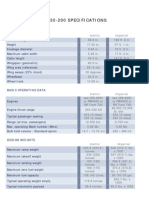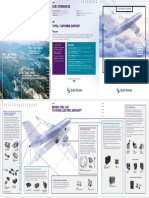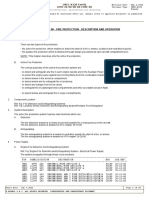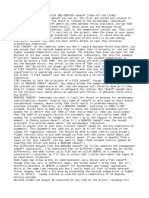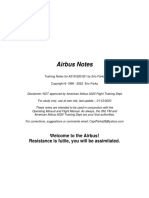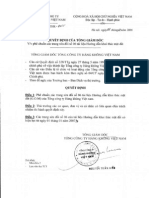EY Ifferences To: Revision Date: 11DEC19
EY Ifferences To: Revision Date: 11DEC19
Uploaded by
rondon9897Copyright:
Available Formats
EY Ifferences To: Revision Date: 11DEC19
EY Ifferences To: Revision Date: 11DEC19
Uploaded by
rondon9897Original Title
Copyright
Available Formats
Share this document
Did you find this document useful?
Is this content inappropriate?
Copyright:
Available Formats
EY Ifferences To: Revision Date: 11DEC19
EY Ifferences To: Revision Date: 11DEC19
Uploaded by
rondon9897Copyright:
Available Formats
A321-200
KEY DIFFERENCES TO A320
Revision Date: 11DEC19
A321-X Differences
A321 vs. A320
It is certainly true that the differences between the A320 and its larger sibling are still rather subtle compared to the wide-body
A330 aircraft family, however there are areas where the A321 feels more like a wide-body jet and the handling differences can
be felt very clearly by pilots. In other words, the A321 features more substantial differences compared to the A320, as opposed
to the smaller A319 compared to the A320.
A longer fuselage and significantly higher weights do alter quite a number of characteristics, which is easy to imagine when
you think about the max. take-off weight being increased by 15.5 tonnes compared to the A320, and the max. landing weight
being increased by 11.8 tonnes. All this while using the same wing, with only minor modifications to the inboard flaps,
increasing lift slightly for take-off and landing.
While it is possible to engineer things out of the aircraft via the fly-by-wire flight control system, some physics can’t be bent by
software.
Different iterations of the CFM56 and IAEV2500 engines also provide for some new characteristics to be noticed.
The Flight Sim Labs A321-X product features all that makes an A321 different to the A320.
A321 VS. A320 KEY POINTS
• Revised flight characteristics that resemble true A321 behaviour and are
A321-X Technical Data not just those of an A320 with higher weight.
• New engine variants with realistic performance and fuel consumption
Max. Take-Off Weight (MTOW): 93.5t
Operating Empty Weight (OEW): 48.5t • Flight Augmentation Computers (FAC) have been re-modelled with
correct speeds (Green Dot, Slats, Flaps, VLS etc.)
Max. Zero Fuel Weight (MZFW): 71.5t
Max. Landing Weight (MLW): 77.8t • Trim settings are accurate to A321 numbers, precisely calibrated to
Centre of Gravity (CG), Angle of Attack (AOA) and Mach number.
• Fuel system re-coded to A321 specifications with proper ECAM fuel
Engine variants page displays. Also, the installation of up to 2 auxiliary fuel tanks (ACT)
IAE V2533-A5 / CFM56-5B3 is supported.
• Proper flaps modelling both visually, and also for accurate lift and drag changes.
• Ground handling revised to resemble changed behaviour due to higher weights and longer wheelbase.
• Exit configuration changed to A321 specifications. The L1 door is still
the main door for boarding, however you may use the L2 door as well
to speed up boarding.
• Supports the removal of brake fans to match the configuration of certain
airframes.
ENGINES
The engine options chosen for the A321-X are the CFM56-3B3 and the IAE V2533-A5, both models featuring the same
maximum thrust rating of 33’000 lbf or 150kN.
You will therefore not notice any handling differences in-flight, however there’s still a small idle thrust difference between the
two models, which is noticeable during taxi.
Last revision: 11DEC19 Page 2 of 4
A321-X Differences
A321 vs. A320
PILOT POINT OF VIEW
The A321-X is a very different aircraft from the 320/319. It is longer, heavier, different flap system and some other different
systems. This means that some study is required before it can be flown well.
On the ground
Even with more powerful engines some power is required to start moving at high weights, even in an IAE-engined aircraft. The
cockpit is further from the main wheels so the pilot will have to 'overturn' slightly when going around corners and lining up on
the runway.
Take-Off
Expect much higher V speeds especially at high weights, so take offs can be much longer. Apart from the speeds, the
technique is the same as the 320/319 except the initial pitch attitude for the SRS will be lower. Also, if an engine fails smooth
pitch control is vital to avoid pitching too high, and therefore loosing speed (consider TOGA power).
Due to these higher V speeds, expect increased runway requirements for many airports, leading to the performance calculation
tool suggesting departure using Flaps 3.
A Flaps 3 take-off is essentially the same as Flaps 1, except the take-off speed is normally lower. On rotation the initial pitch
attitude for SRS will usually be lower. At acceleration altitude lower the nose normally to follow the FD. The speed acceleration
will be slower than F1 (more drag). Allow the aircraft to start to accelerate (positive trend arrow), above F speed and (I would
suggest) 20kt+ above VLS - then select F1. At S speed plus a bit (5-10kt) select the flaps up. As in all Airbus flying, in
bumpy/windshear conditions have some extra margin from VLS. The flaps retract quickly so the limiting speeds are not normally
a problem.
Initial Climb
Be aware of the flap retraction speed (S speed) versus the flap limiting speeds. At high weights S speed may be close to the
red 'barbers' poll. In this case the flaps will auto retract to F1 (just slats) at 210kt (1+F limit of 215kt minus 5kt) and give the
pilot some speed to play with up to the next limit (230kt). Green Dot speed may also be close to, or slightly above, 230kt so a
quick selection of flaps up at 230kt is required to avoid the overspeed. The whole climb out will be SLOW! A careful look at
the PERF page before take-off will give the pilot a 'heads up' so the flap retraction method can be briefed.
When heavy, you can very quickly get yourself into Alpha Floor...It normally happens with turning departures and just above
S speed, you go Flaps 0 and the aircraft passes a waypoint, and as it rolls, VLS charges up because of bank angle and a lack
of slats. Give yourself 10kts past F speed prior to retracting to slats only.
Climb
The climb at 250kt will be only slightly above the GD speed at high weights. Expect lower initial cruise FLs, possibly FL310/320,
when the initial take-off weight is circa 85T plus. The climb speeds above FL100 in the 321 are normally a little higher than
the 320/319 (at a given CI) which will result in an earlier transition to the MACH climb phase. The final stages of the climb will
take some time with rates of climb around 500fpm to be expected.
Cruise
If the pilot is on a long flight expect to carry out one or two step climbs to get the optimum fuel consumption for the flight. Use
the PROG page to assess when to climb. In a 321 it is normally advisable to wait until the Optimum Level is within 500ft of the
next cruise level (i.e. cruising at FL320, OPT FL335 would be ok to climb to FL340). Note - the fuel penalty of cruising 1000ft
away from optimum is less at a lower level in a 321 than higher level (i.e. OPT FL330 and cruising at FL320 would be less fuel
inefficient than cruising at FL340). If the pilot climbs too close to the MAX FL on the PROG page he/she will be faced with a
very narrow operating speed band between VLS and MMO (not good if it gets bumpy!).
Descent
There is no major difference in the descent technique when compared to the 320/319.
One thing to be aware of is the lack of availability of speedbrake at less than 250kts at high landing weights. VLS is always
rising with any use of speedbrake on a clean wing. So at these weights, room for speedbrake use can be very marginal if at
all without using Flap 1 to get the slats out.
If you got high or needed to get down quickly, Flap 1, 225kts and full speedbrake is an option in a high landing weight lowish
speed scenario.
Approach
The maximum landing weight is normally 75.5T in the 321 which results in higher S and F speeds for the approach, and higher
VAPP for landing. However, the gates for the approach (i.e. selecting F2 by 2000ft to go to landing to start the slow down to
be stabilised by 1000ft) remain the same. The amount of speed to lose from S to VAPP is the same as the 320/319, the actual
speeds are just a little higher all round.
Last revision: 11DEC19 Page 3 of 4
A321-X Differences
A321 vs. A320
Approach (continued)
Finally, the flaps are different on the 321 and the angles also. The limiting speeds are higher too, allowing the pilot to select
flaps earlier on the approach. Finally, whereas F3 is recommended in the 320/319 for turbulence etc, Flaps Full is suggested
in the 321. The handling of the 321 in Flaps Full is good, and there will be more room to spare for the tail on touchdown!
Landing
The higher landing speeds will take more distance to stop, and expect higher brake temperatures taxying in. If you need to
keep the brake temperatures down (short turnaround and no brake fans for example) I would suggest landing using Auto
Brake LOW and full reverse.
The 321 is notorious for its tail strike ability. Avoid doing abrupt flare manoeuvres, and if in turbulence you get a high rate of
descent near the ground, just let the aircraft fly on with constant attitude to avoid pulling back and dragging the tail.
Immediate Return after Take Off
At high weights, the manoeuvring speeds will be above the flap limiting speeds. In these situations, selected speeds below
the limit speeds will need to be made before moving the flaps when close to VLS. VLS will move away as the flaps travel
allowing the pilot to go back to managed speeds.
Last revision: 11DEC19 Page 4 of 4
You might also like
- A320 Fcom (16.01.05)Document4,816 pagesA320 Fcom (16.01.05)HaeLyong Joo0% (1)
- Ata 75 - Engine Air CorDocument23 pagesAta 75 - Engine Air CorIdrisNo ratings yet
- Article Wise - A320 Sharklet PDFDocument3 pagesArticle Wise - A320 Sharklet PDFiceman737No ratings yet
- Homebuilt Aircraft Drag ReductionDocument15 pagesHomebuilt Aircraft Drag ReductionYvess100% (2)
- Ceo 51-43-00 - Alternative and Oversize5122214382885977576Document424 pagesCeo 51-43-00 - Alternative and Oversize5122214382885977576Anonymous lQ0rXlvAD100% (2)
- Airbus Flight Crew Training Manual Volume1Document337 pagesAirbus Flight Crew Training Manual Volume1api-3801282100% (13)
- B737-3 ATA 52-30 QC L3 REVB New Original PDFDocument33 pagesB737-3 ATA 52-30 QC L3 REVB New Original PDFTharrmaselan VmanimaranNo ratings yet
- EASA TCDS E.007 (IM) General Electric CF6 80E1 Series Engines 02 25102011Document9 pagesEASA TCDS E.007 (IM) General Electric CF6 80E1 Series Engines 02 25102011Graham WaterfieldNo ratings yet
- Airbus AC A380 20131201Document380 pagesAirbus AC A380 20131201laxmans20No ratings yet
- ATA 29 Level 1Document28 pagesATA 29 Level 1Saman Mahdi AbadiNo ratings yet
- Final Fix / Retrofit General Introduction: Exit MenuDocument28 pagesFinal Fix / Retrofit General Introduction: Exit MenugygjhkjnlNo ratings yet
- Pitot Static TestsetDocument13 pagesPitot Static TestsetMedaNo ratings yet
- Specifications Airbus Series 2Document4 pagesSpecifications Airbus Series 2flightstudentNo ratings yet
- EMC 1-STN-Level 2 3-ATA 46 PDFDocument10 pagesEMC 1-STN-Level 2 3-ATA 46 PDFbasid911No ratings yet
- A318/A319/A320/A321: Service BulletinDocument78 pagesA318/A319/A320/A321: Service BulletinPradeep K sNo ratings yet
- A320 30 L1 TMDocument48 pagesA320 30 L1 TMSaman Mahdi Abadi100% (2)
- Inventory Cfm56 5Document4 pagesInventory Cfm56 5Fitrah Firdaus100% (1)
- B Trent41368ATDocument81 pagesB Trent41368ATArabyAbdel Hamed SadekNo ratings yet
- A320 DataDocument29 pagesA320 DataGustavo Nostray Yafar0% (1)
- A318/A319/A320/A321: Service BulletinDocument128 pagesA318/A319/A320/A321: Service BulletinPradeep K sNo ratings yet
- Flight Control System - The Way To More Electrical AircraftDocument2 pagesFlight Control System - The Way To More Electrical AircraftrakkaNo ratings yet
- 70V25Document52 pages70V25Zbor ZborNo ratings yet
- A320fam Iae Ata78 Exhaust PDFDocument42 pagesA320fam Iae Ata78 Exhaust PDFshabbirjama103No ratings yet
- Ata 22Document10 pagesAta 22Raby AbidiNo ratings yet
- Electrical Bonding of Electrical ConnectorsDocument4 pagesElectrical Bonding of Electrical ConnectorsLisanNo ratings yet
- A320 Ata 26Document18 pagesA320 Ata 26KOPHIDA AEROSPACENo ratings yet
- Ata 49 Apu Apic PDFDocument174 pagesAta 49 Apu Apic PDFdavidNo ratings yet
- 2X 2 23 PDFDocument124 pages2X 2 23 PDFRaby AbidiNo ratings yet
- ATA 30 - Ice & Rain 09-04-18 PDFDocument143 pagesATA 30 - Ice & Rain 09-04-18 PDFDavid OwenNo ratings yet
- U28B102Document39 pagesU28B102Raby Abidi100% (1)
- Safety First 2 (Sep 05)Document28 pagesSafety First 2 (Sep 05)IYIBIRINo ratings yet
- Ata 28Document27 pagesAta 28jontis jasoliyaNo ratings yet
- Fadec: Navigation SearchDocument4 pagesFadec: Navigation SearchArjun AnduriNo ratings yet
- A318 Diffs B1 & 2 PT 1 of 2Document216 pagesA318 Diffs B1 & 2 PT 1 of 2Mrityunjay Kumar JhaNo ratings yet
- Leap EngineDocument1 pageLeap Enginevishal kumar sinhaNo ratings yet
- Ficha Técnica Airbus A-320: Technical SpecsDocument4 pagesFicha Técnica Airbus A-320: Technical SpecsAlexander MolinaNo ratings yet
- A320family EASA Required Placards and MarkingsDocument47 pagesA320family EASA Required Placards and MarkingsSMSM TVNo ratings yet
- A320fam Iae Ata79 Oil PDFDocument42 pagesA320fam Iae Ata79 Oil PDFshabbirjama103No ratings yet
- Landing Gear: AIRBUS A350-900Document1 pageLanding Gear: AIRBUS A350-900kiran2381No ratings yet
- 28.26.00006 07-JUL-2023 05-SEP-2023 Open A318, A319, A320, A321 28-00 UpdateDocument17 pages28.26.00006 07-JUL-2023 05-SEP-2023 Open A318, A319, A320, A321 28-00 UpdateYaser SahiboleNo ratings yet
- Emc 7e-Ttm-Level 2 3-Ata 28Document22 pagesEmc 7e-Ttm-Level 2 3-Ata 28caicaaa071No ratings yet
- Ata 21 TrsonDocument160 pagesAta 21 TrsonTam Ho100% (1)
- Fin EntryDocument56 pagesFin Entrymohammad qaruishNo ratings yet
- Airbus A380: A Double Deck, Wide-Body, Four-Engine Airliner Manufactured by The European Corporation AirbusDocument19 pagesAirbus A380: A Double Deck, Wide-Body, Four-Engine Airliner Manufactured by The European Corporation Airbuspseudonomous actualityNo ratings yet
- Kink Seal FlapDocument9 pagesKink Seal FlapJivendra KumarNo ratings yet
- Single Aisle DIFF COURSE A318/319/320/321 ENHANCED To A319/320/321 Classic Technical Training Manual Aircraft General PracticesDocument12 pagesSingle Aisle DIFF COURSE A318/319/320/321 ENHANCED To A319/320/321 Classic Technical Training Manual Aircraft General PracticesjoeNo ratings yet
- ATA 30 Ice and RainDocument10 pagesATA 30 Ice and RainAlejandroNo ratings yet
- Emc 7e-Ttm-Level 2 3-Ata 36Document80 pagesEmc 7e-Ttm-Level 2 3-Ata 36caicaaa071No ratings yet
- Tso PitotDocument8 pagesTso PitotElkin CuevasNo ratings yet
- SR Technics: 57 WingsDocument10 pagesSR Technics: 57 WingsJimmy HaddadNo ratings yet
- Ata27.flight Controls 1614086442267 39Document46 pagesAta27.flight Controls 1614086442267 39basid930No ratings yet
- Quick Engine Change and CowlsDocument4 pagesQuick Engine Change and CowlsLahu KureNo ratings yet
- ata25NAMMAIJA 000016Document2,076 pagesata25NAMMAIJA 000016Héctor PicazoNo ratings yet
- Catalogue Nacelle Tooling A320neoDocument31 pagesCatalogue Nacelle Tooling A320neoPablo RestrepoNo ratings yet
- A320 ReferencesDocument30 pagesA320 ReferencesHarish PatelNo ratings yet
- B737 Use of Take Off ChartsDocument11 pagesB737 Use of Take Off ChartsmohammedredhadjoudiNo ratings yet
- A32X Fun FacsDocument3 pagesA32X Fun FacsDemostene NeacsiuNo ratings yet
- Flex Vs DeratedDocument2 pagesFlex Vs Deratedmohamadi charia100% (1)
- Airbusnotes PDFDocument138 pagesAirbusnotes PDFRohit SinghNo ratings yet
- Airbusa320aircraftoperationmanual 121006002632 Phpapp01Document86 pagesAirbusa320aircraftoperationmanual 121006002632 Phpapp01Jose PascualNo ratings yet
- AirbusnotesDocument139 pagesAirbusnotesANDRESXOXNo ratings yet
- Us AirwaysDocument136 pagesUs AirwaysGPP10822100% (2)
- Use of Takeoff Charts (B737)Document14 pagesUse of Takeoff Charts (B737)Captainkhoso100% (1)
- Requirements:: PMDG 737 Ngxu Fs2Crew PMDG 737 Ngxu Edition. Available At: This Tutorial Uses WithDocument32 pagesRequirements:: PMDG 737 Ngxu Fs2Crew PMDG 737 Ngxu Edition. Available At: This Tutorial Uses Withrondon9897No ratings yet
- Manual: Updated September 8Th, 2019Document91 pagesManual: Updated September 8Th, 2019rondon9897No ratings yet
- Piper PA-32-260 Cherokee Six G-BHGO 08-06Document3 pagesPiper PA-32-260 Cherokee Six G-BHGO 08-06rondon9897No ratings yet
- The Flibberty-FlobberDocument2 pagesThe Flibberty-Flobberrondon9897No ratings yet
- Requirements:: PMDG 737 Ngxu Fs2Crew PMDG 737 Ngxu Edition. Available At: This Tutorial Uses WithDocument32 pagesRequirements:: PMDG 737 Ngxu Fs2Crew PMDG 737 Ngxu Edition. Available At: This Tutorial Uses Withrondon9897No ratings yet
- Requirements:: PMDG 737 Ngxu Fs2Crew PMDG 737 Ngxu Edition. Available At: This Tutorial Uses WithDocument30 pagesRequirements:: PMDG 737 Ngxu Fs2Crew PMDG 737 Ngxu Edition. Available At: This Tutorial Uses Withrondon9897No ratings yet
- Important Ultimate Ground Crew X' Info For Ngx-U Users!Document1 pageImportant Ultimate Ground Crew X' Info For Ngx-U Users!rondon9897No ratings yet
- Paddle 5Document31 pagesPaddle 5rondon9897No ratings yet
- The Airport: MK-STUDIOS Dublin P3DV4 and V5 Manual V1.20Document7 pagesThe Airport: MK-STUDIOS Dublin P3DV4 and V5 Manual V1.20rondon9897No ratings yet
- New OpenDocument TextDocument1 pageNew OpenDocument Textrondon9897No ratings yet
- RXP GTN 750/650 TOUCH: User's Manual For Prepar3d / Flight SimDocument28 pagesRXP GTN 750/650 TOUCH: User's Manual For Prepar3d / Flight Simrondon9897No ratings yet
- Demis Roussos V Richard BransonDocument32 pagesDemis Roussos V Richard Bransonrondon9897No ratings yet
- Individual Roster: 01FEB2016 - 29FEB2016 H-Rish 788Document2 pagesIndividual Roster: 01FEB2016 - 29FEB2016 H-Rish 788rondon9897No ratings yet
- Biggles Goes To The HairdressersDocument34 pagesBiggles Goes To The Hairdressersrondon9897No ratings yet
- Hello Guernsey!Document30 pagesHello Guernsey!rondon9897No ratings yet
- Hello You Cheeky Littlb MonketsDocument1 pageHello You Cheeky Littlb Monketsrondon9897No ratings yet
- A 320 Perf Fuel SavingDocument51 pagesA 320 Perf Fuel Savingrondon9897100% (1)
- Aava QuestionsDocument7 pagesAava Questionsrondon9897No ratings yet
- Add-On Scenery For MS FS2004, FSX & Prepar3D: InstallationDocument10 pagesAdd-On Scenery For MS FS2004, FSX & Prepar3D: Installationrondon9897No ratings yet
- A330 ECAM PhilosophyDocument14 pagesA330 ECAM Philosophyrondon9897No ratings yet
- Action and Malfunction CodesDocument4 pagesAction and Malfunction Codesrondon9897No ratings yet
- You Little Tongtong Birmingham Tish TishDocument1 pageYou Little Tongtong Birmingham Tish Tishrondon9897No ratings yet
- Hell TKHDocument1 pageHell TKHrondon9897No ratings yet
- Bsi LPTDocument37 pagesBsi LPT王马No ratings yet
- Aircraft Maintenance CheckDocument12 pagesAircraft Maintenance CheckPopol BenavidezNo ratings yet
- 71-00-00-710-005-B - Start AbortDocument2 pages71-00-00-710-005-B - Start AbortEder LucianoNo ratings yet
- ON A/C FSN 251-300: Figure 36-11-86-54 SHEET 01/3 Figure 36-11-86-54 SHEET 02/3 Figure 36-11-86-54 SHEET 03/3Document6 pagesON A/C FSN 251-300: Figure 36-11-86-54 SHEET 01/3 Figure 36-11-86-54 SHEET 02/3 Figure 36-11-86-54 SHEET 03/3quynhNo ratings yet
- A318/A319/A320/A321: Service BulletinDocument123 pagesA318/A319/A320/A321: Service BulletinPradeep K s100% (1)
- FCOMDocument5,006 pagesFCOMMudassar Mushtaq100% (1)
- Delta Domestic Schedule2024Document188 pagesDelta Domestic Schedule2024Fernando LuizNo ratings yet
- A320 NE0 Fuel or Hydraulic or Oil Leakage LimitsDocument19 pagesA320 NE0 Fuel or Hydraulic or Oil Leakage LimitsArjuna SamaranayakeNo ratings yet
- A320 51-57 StructureDocument242 pagesA320 51-57 StructureSelahattin kotayNo ratings yet
- Part B - A320 & A321 - EnglishDocument113 pagesPart B - A320 & A321 - Englishapi-3705891No ratings yet
- Timetable 2013 Air IndiaDocument17 pagesTimetable 2013 Air Indiasunshine_avenueNo ratings yet
- A318/A319/A320/A321: Service BulletinDocument57 pagesA318/A319/A320/A321: Service BulletinPradeep K s100% (1)
- General Refuel-Defuel Safety ProceduresDocument6 pagesGeneral Refuel-Defuel Safety ProceduresrameshneupaneNo ratings yet
- QRH A320 PDFDocument238 pagesQRH A320 PDFrondon9899No ratings yet
- Title: Inert Gas System - Inert Gas Generation System (Iggs) - Redesign Iggs Pallet Frame, Filter and DuctsDocument47 pagesTitle: Inert Gas System - Inert Gas Generation System (Iggs) - Redesign Iggs Pallet Frame, Filter and Ductsmanartb25No ratings yet
- ECOM-2020 280 R05 - JQ NoticeDocument3 pagesECOM-2020 280 R05 - JQ NoticeBrian SchoutenNo ratings yet
- Easa Airworthiness Directive: AD No.: 2012-0118Document426 pagesEasa Airworthiness Directive: AD No.: 2012-0118andres orjuelaNo ratings yet
- Square Gasket PDFDocument2 pagesSquare Gasket PDFGoutam SahaNo ratings yet
- Msao PK-GTJ Robbing Edu, Video For PK-GQMDocument8 pagesMsao PK-GTJ Robbing Edu, Video For PK-GQMangge supriyantoNo ratings yet
- GOW - A318 - A319 - A320 - A321 - AMM - FSN - 103 - 01-Aug-2024 - 12-13-27-612-001-A - Oil Replenishment of The THS ActuatorDocument5 pagesGOW - A318 - A319 - A320 - A321 - AMM - FSN - 103 - 01-Aug-2024 - 12-13-27-612-001-A - Oil Replenishment of The THS Actuator225248No ratings yet
- NKS - A318 - A319 - A320 - A321 - AMM - 01-Aug-2023 - 73-21-01-000-801-A - Removal of The Electronic Engine Control (EEC)Document8 pagesNKS - A318 - A319 - A320 - A321 - AMM - 01-Aug-2023 - 73-21-01-000-801-A - Removal of The Electronic Engine Control (EEC)Rodrigo ArgoteNo ratings yet
- Title: Doors - Main Gear Doors - Introduce New Fairing Attachment Stud AssembliesDocument936 pagesTitle: Doors - Main Gear Doors - Introduce New Fairing Attachment Stud AssembliesRk PaniNo ratings yet
- HP Bleed Valve FaultDocument9 pagesHP Bleed Valve FaultSuman BajracharyaNo ratings yet
- AMM - JAT - A318/A319/A320/A321 REV DATE: May 01/2022 Tail Number - MSN - FSN: CC-AWK - 09328 - 102Document15 pagesAMM - JAT - A318/A319/A320/A321 REV DATE: May 01/2022 Tail Number - MSN - FSN: CC-AWK - 09328 - 102Andre SanarNo ratings yet
- Vol5-Checklist EN PDFDocument3 pagesVol5-Checklist EN PDFsasha_saleNo ratings yet
- Burn Mark AdlDocument25 pagesBurn Mark AdlLONG VUNo ratings yet
- A318/A319/A320/A321: Flight Crew Training ManualDocument6 pagesA318/A319/A320/A321: Flight Crew Training ManualLuiz Fernando CarvalhoNo ratings yet












